designed for the way women work.
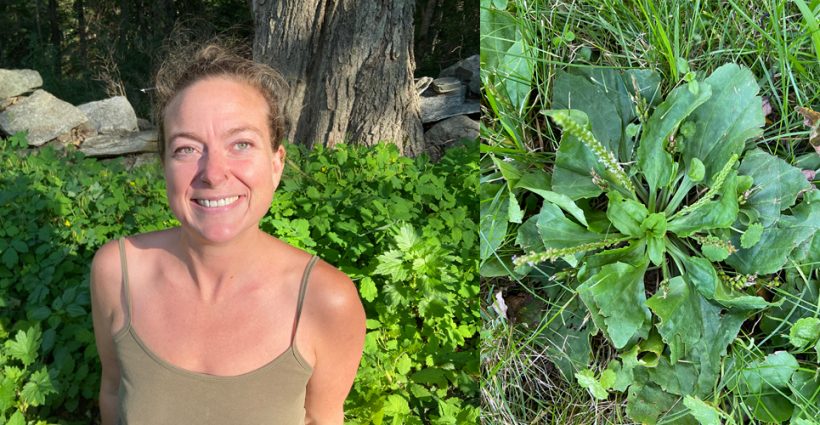
Beneficial Weeds: Foraging in your Backyard, by Jeannette Ross
Category: How-To Projects, Plant Ideas & Info, Presenting "The Curious Gardener", Strong Women Building A Gentle World
If your natural surroundings are anything like mine, there is an untapped bounty of plants unrecognized for their nutritional and medicinal benefits.
That’s what Sarah Lucas — a farmer, forager and teacher with Harlem Valley Homestead in Wingdale, N.Y. — told me when she visited my home. Almost everything I dismissed as a weed — noxious or benign — has a useful side, we just need to recognize it. Goldenrod, dandelion, garlic mustard, lady’s thumb, knot weed, dock, even my nemesis, mugwort.
“I am so passionate about wild edibles,” said Sarah, who is dedicated to helping people see the resources in their backyards and beyond.
Sarah has spent much of her life studying the sciences, from biology to ecology, as well as psychology and philosophy. With two masters in theology, she has woven her interests into ecotheology, which manifests itself for her through farming.
“What I find spiritually meaningful led to an ethical imperative to work in agriculture that isn’t destructive and to teach others that our food choices impact the environment,” she said.
After six years of farming — and two years off due to a back injury — Sarah joined the team at Harlem Valley Homestead, where hens, pigs, cattle, honeybees and vegetables are humanely and sustainably raised. Its team’s mission is to bring people together on a working farm to learn how to live “a life connected with land, with each other, and with ourselves.”
One of the things Sarah is involved in is teaching classes on foraging.
“One of the biggest benefits of foraging is that you have this feeling of strength, because you are not only empowered by knowing what you can eat, but you are also learning about first aid and medicine,” she said. She sees people afraid of the outdoors because of the possibility of injuries or bee stings. “That’s such an important bubble to pop,” she said, adding she aims to help “empower people to be outdoors comfortably.”
And comfortable she is, as she walked around my unruly yard in her bare feet looking for plants to talk about. She did not have to go far.
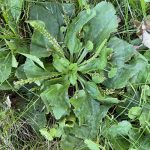
My lawn is only part grass and one of the plants adding to the greenery is plantain (Plantago major or P. lanceolata ). This plant, so easily found along sidewalks and in backyards, does pretty much everything, she said, being “fantastic first aid while also being edible.” She likes to focus on its medicinal benefits, which includes relieving bee stings when made into a poultice.
“You chew it up with a lot of saliva so it is a gooey paste, put it on your wound and it will harden like a Bandaid,” she said. According to Sarah, this will reduce swelling, disinfect and draw out toxins, help close the wound and significantly lessen pain.
As far as eating the plant, Sarah likes to bake the leaves into chips, but said it can also be used in smoothies and pestos. Nutritionally, plantain provides Vitamins A, B1, B3, B6, B12 and C, fiber, calcium, potassium, zinc, iron, magnesium, selenium, chloride, and phosphorus.
Dandelion (Taraxacum officinale) is another of Sarah’s favorites because every part of the plant is edible. It provides, she said, more antioxidants, calcium, and vitamins A, K and E than spinach. One cup of greens provides a person’s daily requirements of beta-carotene, calcium, iron and potassium, she said. The flowers can be turned into dandelion wine.
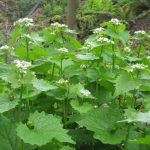
Garlic mustard (Alaria petiofola) was brought here by European settlers as a nutrient-dense herb and vegetable, Sarah said. Loaded with Vitamin C and beta carotene, it can be made into a pesto and its seeds have a peppery taste to sprinkle on salads. Medicinally, it can be made into a hot tea to alleviate asthma and bronchitis. A poultice can relieve the itching of insect bites. Check out a recipe we posted on The Curious Gardener for garlic mustard pesto here.
Hairy bittercress (Cardamine hirsuta) is one of many brassicas that can be eaten as a salad when it pops up in spring. It’s mild and peppery flavor will deliver a healthy dose of vitamin C, calcium, magnesium, beta-carotene, and antioxidants.
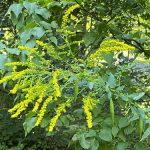
The flowers and leaves of goldenrod (Solidago), blooming profusely now in the Northeast, can be brewed into a pale, golden tea that has more antioxidants than green tea. A handout Sarah gives to her classes touts the plant for lowering histamine levels, boosting the immune system, helping the kidneys and urinary tract, and its antimicrobial, antibacterial and anti-fungal properties.
While day lilies (Hemerocallis fulva) are a cultivated plant, many people may not know that these orange beauties, before the flowers open, are a common ingredient in Asian dishes like hot and sour soup and stir fries. Some people, Sarah warned, may have an allergic reaction.
Jewelweed (Impatiens capensis) is well known for its soothing properties treating stings, sunburn, skin irritations and poison ivy rashes. Use externally as ice cubes, a vinegar, or a spray in witch hazel.
Wood sorrel (Oxalis stricta) has a sweet and sour lemon flavor which goes along with its high quotient of Vitamin C. It can be made into a cooling drink or as an astringent.
That brings us to two plants — knotweed and mugwort — which Sarah believes need some reputation rehabilitation. Both plants, looked down on as non-native invasives, have positive attributes, she said.
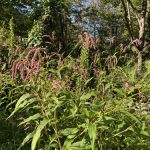
I spent two years eradicating a Japanese knotweed (Fallopia japonica) plant, but now I have a stand of Lady’s thumb (Persicaria), another type of knotweed. Knotweed is recognized as edible and has high levels of the antioxidant resveratrol. For her classes, Sarah makes a fruit leather of the young spring shoots that she says tastes like rhubarb.
Mugwort (Artemisia vulgaris) has a long history of human use that includes flavoring for beer. It was brought to this country in the 1600s for medicinal purposes. A versatile plant, it can be eaten raw, dried for seasoning, brewed for tea, made into tinctures, and used in a bath for sore muscles. When she is out walking Sarah crushes it and rubs it on her skin as it has insect repellent properties and she has smoked it in place of tobacco. In folklore, aromatic mugwort is tucked in pillows to promote lucid dreams.
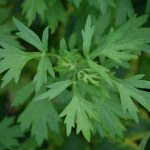
Some of these plants are invasive, and that is a term Sarah waits to use until the end of her classes.
“It’s important to encounter plants without presuppositions about whether a plant is valuable based on whether it is native or not,” she said. “Everything has been invasive at some time. Plants and animals and fungi have been circulating the globe since life started,” she said.
It’s often a matter of perspective. Wheat, honeybees and earthworms are not native to this country. “No one talks about that because we consider them to be positive for us. We come from a narrow point of view,” she said.
Sarah recognizes the strong feelings that can arise during a native vs. non-native discussion, and she is not advocating bringing non-native plants into an ecosystem.
“What’s important is to remember they have uses that are often unrecognized because we are so angry about them,” she said. “The way we get rid of them is poisoning everyone. We just need to slow down and learn more about what we are doing.”
To that end, one of her goals is to offer a service where she shows people the uses of plants growing at their homes; how to make a meal from them, and to shift the psychology away from manicured and chemical-ridden properties.
“Our idea of beauty is being sterile and controlled. If we can shift that idea, it would be a huge step in environmental health and resilience.”
For more information for beginners, Sarah recommends the following:
Foraging and Feasting; A Field Guide and Wild Food Cookbook by Dina Falconi
Backyard Foraging, 65 Familiar Plants You Didn’t Know You Could Eat, by Ellen Zachos
Northeast Medicinal Plants, by Liz Neves
Sarah will also offer classes on foraging on Sept. 17 at Great Hollow Nature Preserve in New Fairfield, Conn., and Sept. 30 at Harlem Valley Homestead.



Thanks for sharing this with us
Very good information to share and appreciate